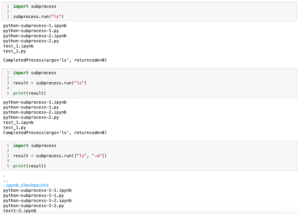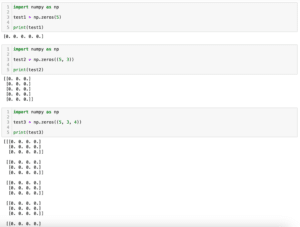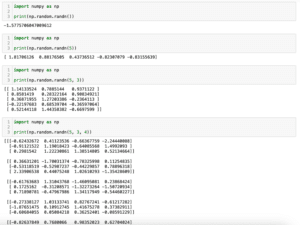NumPy
前回、subprocessモジュールを使ってPythonからターミナルやコマンドプロンプトを操作する方法を紹介しました。
あわせて読みたい


【Python基礎】subprocessモジュールを使ってPythonからターミナルやコマンドプロンプトを操作する方法…
subprocess 前回、PythonのSciPyでcurve_fitを用いてピークフィッティングする方法を紹介しました。 今回はsubprocessモジュールを使ってPythonからターミナルやコマン…
今回はPythonのNumPyで全ての要素が1の配列を作成する方法を紹介します。
実は前に「全ての要素が0の配列を作成する方法」として、「np.zeros()」「np.zeros_like()」という関数を紹介しました。
あわせて読みたい


【NumPy】全ての要素が0の配列を作成する方法(np.zeros、np.zeros_like)[Python]
NumPy 前回、PythonのNumPyを使ったランダムな値の取得方法を紹介しました。 今回は全ての要素が0の配列を作成する方法を紹介します。 それでは始めていきましょう。 n…
今回はそれの要素が1のバージョンです。
それでは始めていきましょう。
np.ones():全ての要素が1の配列を作成
全ての要素が1の配列を作成するには「np.ones()」を用います。
引数として数値を与えるとその数だけ要素として1をもつ配列を作成します。
import numpy as np
test1 = np.ones(5)
print(test1)
実行結果
[1. 1. 1. 1. 1.]引数をタプルで複数の数値を与えると二次元配列、三次元配列として全ての要素を1としてもつ配列を作成できます。
import numpy as np
test2 = np.ones((5, 3))
print(test2)
実行結果
[[1. 1. 1.]
[1. 1. 1.]
[1. 1. 1.]
[1. 1. 1.]
[1. 1. 1.]]import numpy as np
test3 = np.ones((5, 3, 4))
print(test3)
実行結果
[[[1. 1. 1. 1.]
[1. 1. 1. 1.]
[1. 1. 1. 1.]]
[[1. 1. 1. 1.]
[1. 1. 1. 1.]
[1. 1. 1. 1.]]
[[1. 1. 1. 1.]
[1. 1. 1. 1.]
[1. 1. 1. 1.]]
[[1. 1. 1. 1.]
[1. 1. 1. 1.]
[1. 1. 1. 1.]]
[[1. 1. 1. 1.]
[1. 1. 1. 1.]
[1. 1. 1. 1.]]]「np.zeros()」と同様に二次元配列、三次元配列などを作成する際、タプルで値を与えず、そのまま引数として与えてしまうとエラーとなります。
import numpy as np
test4 = np.ones(5, 3)
print(test4)
実行結果
---------------------------------------------------------------------------
TypeError Traceback (most recent call last)
Cell In[4], line 3
1 import numpy as np
----> 3 test4 = np.ones(5, 3)
5 print(test4)
File /Library/Frameworks/Python.framework/Versions/3.10/lib/python3.10/site-packages/numpy/core/numeric.py:191, in ones(shape, dtype, order, like)
188 if like is not None:
189 return _ones_with_like(like, shape, dtype=dtype, order=order)
--> 191 a = empty(shape, dtype, order)
192 multiarray.copyto(a, 1, casting='unsafe')
193 return a
TypeError: Cannot interpret '3' as a data typenp.ones_like():既存の配列と同じ構造で要素が1の配列を作成
次に既にある配列と同じ構造で要素が1の配列を作成する方法を紹介します。
その場合は「np.ones_like(配列)」を用います。
前に紹介した「np.random.rand()」を用いて、ランダムな要素をもつ配列を作成した後、その配列と同じ構造で要素が1の配列を作成してみます。
あわせて読みたい


【NumPy】NumPyを使ったランダムな値の取得方法[Python]
NumPy 前回、Pythonで再帰処理を大量に行った場合に出る「RecursionError: maximum recursion depth exceeded while calling a Python object」の対処法を紹介しました…
import numpy as np
test5 = np.random.rand(5, 3)
test6 = np.ones_like(test5)
print(test5)
print(test6)
実行結果
[[0.74090614 0.72736735 0.48055415]
[0.58298606 0.58193389 0.88854095]
[0.60068622 0.31540923 0.63189884]
[0.38554233 0.56482393 0.94900833]
[0.05408992 0.89743998 0.22695272]]
[[1. 1. 1.]
[1. 1. 1.]
[1. 1. 1.]
[1. 1. 1.]
[1. 1. 1.]]次回は逆フーリエ変換をして不要な周波数成分を除去する方法(ローパスフィルタ、ハイパスフィルタ、バンドパスフィルタ)を紹介します。
あわせて読みたい


【NumPy】逆フーリエ変換をして不要な周波数成分を除去する方法(ローパスフィルタ、ハイパスフィルタ、…
NumPy 前回、PythonのNumPyで全ての要素が1の配列を作成する方法を紹介しました。 今回は逆フーリエ変換をして不要な周波数成分を除去する方法、すなわちローパスフィ…
ではでは今回はこんな感じで。

コメント